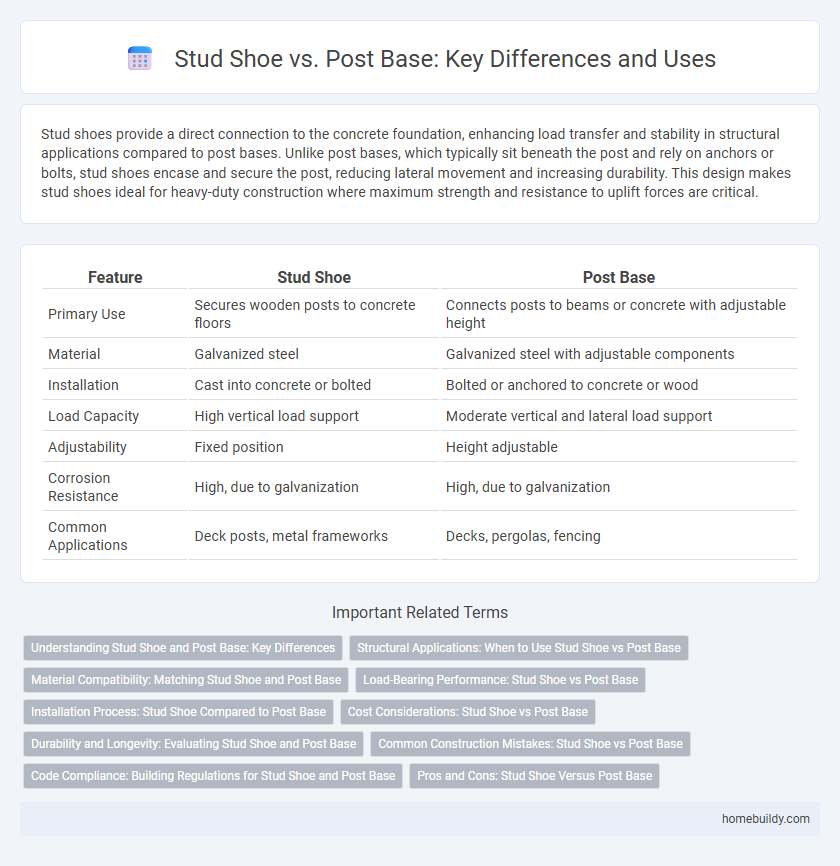Stud shoes provide a direct connection to the concrete foundation, enhancing load transfer and stability in structural applications compared to post bases. Unlike post bases, which typically sit beneath the post and rely on anchors or bolts, stud shoes encase and secure the post, reducing lateral movement and increasing durability. This design makes stud shoes ideal for heavy-duty construction where maximum strength and resistance to uplift forces are critical.
Table of Comparison
| Feature | Stud Shoe | Post Base |
|---|---|---|
| Primary Use | Secures wooden posts to concrete floors | Connects posts to beams or concrete with adjustable height |
| Material | Galvanized steel | Galvanized steel with adjustable components |
| Installation | Cast into concrete or bolted | Bolted or anchored to concrete or wood |
| Load Capacity | High vertical load support | Moderate vertical and lateral load support |
| Adjustability | Fixed position | Height adjustable |
| Corrosion Resistance | High, due to galvanization | High, due to galvanization |
| Common Applications | Deck posts, metal frameworks | Decks, pergolas, fencing |
Understanding Stud Shoe and Post Base: Key Differences
Stud shoes and post bases serve distinct functions in structural construction, with stud shoes primarily designed to provide a secure anchoring point for vertical wood studs to concrete or steel surfaces. Post bases offer enhanced support for larger posts by transferring loads directly to the foundation, often featuring adjustable brackets to accommodate various post sizes. Selecting the appropriate component depends on factors such as load requirements, material compatibility, and installation conditions.
Structural Applications: When to Use Stud Shoe vs Post Base
Stud shoes are ideal for securing wood posts to concrete foundations where increased lateral stability and load distribution are required, especially in high-wind or seismic regions. Post bases offer simpler installation for lighter structural applications, providing adequate elevation and protection against moisture while maintaining basic load-bearing capabilities. Choosing between the two depends on the load demands and environmental exposure, with stud shoes preferred for heavy-duty structural support and post bases suited for residential or light commercial framing.
Material Compatibility: Matching Stud Shoe and Post Base
Selecting a stud shoe that matches the material of the post base ensures optimal structural integrity and corrosion resistance. For example, stainless steel stud shoes paired with stainless steel post bases prevent galvanic corrosion in outdoor applications. Matching materials such as galvanized steel stud shoes with galvanized post bases enhances durability by maintaining consistent protective coatings.
Load-Bearing Performance: Stud Shoe vs Post Base
Stud shoes provide superior load-bearing performance by directly anchoring structural posts to concrete foundations, enabling efficient transfer of vertical and lateral loads. Post bases offer a secure connection but often rely on an embedded anchor bolt, which can reduce load capacity under heavy stress conditions. Engineering studies demonstrate that stud shoes reduce deflection and improve stability in load-critical framing compared to traditional post bases.
Installation Process: Stud Shoe Compared to Post Base
Stud shoes simplify the installation process by providing a built-in anchoring system that attaches directly to the concrete foundation, eliminating the need for separate post base hardware. This integrated design reduces installation time and ensures a secure connection for wood framing elements. In contrast, post bases require additional positioning and fasteners, potentially increasing labor and alignment challenges during setup.
Cost Considerations: Stud Shoe vs Post Base
Stud shoes generally offer a lower initial cost compared to post bases, making them a budget-friendly option for securing wood posts to concrete. Post bases, while often more expensive upfront, provide enhanced durability and corrosion resistance, potentially reducing long-term maintenance and replacement expenses. Evaluating both options requires balancing immediate budget constraints against projected lifecycle costs and structural performance needs.
Durability and Longevity: Evaluating Stud Shoe and Post Base
Stud shoes provide enhanced durability and longevity by securely fixing structures to concrete, minimizing corrosion and wear through galvanized steel materials. Post bases offer reliable anchoring but are more susceptible to environmental damage, often requiring more frequent maintenance or replacement. Choosing stud shoes ensures a longer lifespan and increased resistance to structural stress in outdoor and high-moisture conditions.
Common Construction Mistakes: Stud Shoe vs Post Base
Common construction mistakes when choosing between stud shoes and post bases include improper alignment and insufficient anchoring, which compromise structural stability. Stud shoes often fail due to incorrect nailing or underestimating load requirements, while post bases are frequently installed without adequate embedment depth or concrete curing time. Ensuring precise placement and adherence to manufacturer specifications prevents these errors and enhances joint durability in framing systems.
Code Compliance: Building Regulations for Stud Shoe and Post Base
Stud shoes and post bases both must meet specific building regulations such as the International Residential Code (IRC) and International Building Code (IBC) to ensure structural safety and compliance. Stud shoes are typically used to support timber studs in wall framing, providing lateral stability and resisting uplift forces, while post bases anchor vertical posts to concrete foundations, preventing moisture intrusion and ensuring load transfer. Compliance with building codes requires correct selection, installation, and use of components with appropriate corrosion resistance and load ratings to meet local structural and seismic demands.
Pros and Cons: Stud Shoe Versus Post Base
Stud shoes provide excellent lateral stability and load transfer for timber posts, making them ideal for heavy structural applications and resisting shear forces. Post bases offer superior corrosion resistance and easier installation by elevating the post above concrete, reducing rot and extending the lifespan of wooden structures. Choosing between stud shoes and post bases depends on balancing structural rigidity with protection from environmental damage in your specific construction context.
Stud shoe vs post base Infographic

 homebuildy.com
homebuildy.com